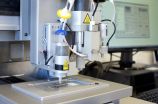Wine-making shortcut gives bubbly a fruitier aroma
2015-06-17
(Press-News.org) The best sparkling wines take months to ferment to perfection. In recent years, many winemakers have turned to commercial yeast products to give this process a boost. How they ultimately affect bubbly has been an open question, but now scientists have stepped in to find out. They report their findings in ACS' Journal of Agricultural and Food Chemistry.
When sparkling wine is made, yeast cells burst open in a process called autolysis. This releases a special kind of protein called mannoproteins that, in still wines (the non-bubbly kind), can reduce astringency and bitterness, improve aroma and enhance body. Although commercial products rich in these mannoproteins are already used to make both regular and sparkling wines, few studies have looked into how well they work in the effervescent varieties. Silvia Pérez-Magariño and colleagues wanted to fill that void.
The researchers made different varieties of sparkling wine with four yeast autolysates. They found that in general, the added autolysates didn't affect the foam quality of the wines or the phenolic compound content. One product, which was associated with a 21 to 34 percent increase in mannoproteins, enhanced the fruity aromas in some of the wines.
INFORMATION:
The authors acknowledge funding from Instituto Nacional de Investigación y Tecnología Agraria y Alimentaria and the government of La Rioja (Spain).
The American Chemical Society is a nonprofit organization chartered by the U.S. Congress. With more than 158,000 members, ACS is the world's largest scientific society and a global leader in providing access to chemistry-related research through its multiple databases, peer-reviewed journals and scientific conferences. Its main offices are in Washington, D.C., and Columbus, Ohio.
To automatically receive news releases from the American Chemical Society, contact newsroom@acs.org.
Follow us: Twitter
Facebook
ELSE PRESS RELEASES FROM THIS DATE:
2015-06-17
Researchers from Cardiff University have pioneered a new technique that will enable scientists to precisely pinpoint the areas on an enzyme that help to speed up chemical reactions.
By labelling certain segments of an enzyme with heavy isotopes, the researchers have found that 'heavy' and 'light' versions of enzymes have different catalytic properties, allowing them to determine which regions are linked to specific functions.
It is hoped this precise pinpointing may shed light on why enzymes are much more efficient at speeding up chemical reactions compared to man-made ...
2015-06-17
LOS ANGELES -- In two ancillary studies of two multi-center international clinical trials led by the University of Southern California (USC) Eye Institute, the injectable drug ocriplasmin appears to improve vision among patients suffering from symptomatic vitreomacular adhesion (VMA), a condition related to the aging eye that could cause permanent vision loss if left untreated.
'These are the first large studies that document patient-reported visual improvement after injection of ocriplasmin for symptomatic VMA,' said Rohit Varma, M.D., M.P.H., director of the USC Eye ...
2015-06-17
Lisbon, 17 June 2015: An IVF technique which freezes all embryos generated in an initial treatment cycle and transfers them in a later cycle as freeze-thawed embryos does not improve outcome as some studies have suggested.
Results of the study, performed at the Instituto Valenciano de Infertilidad (IVI) clinic in Valencia, Spain, are presented today at the ESHRE Annual Meeting by Dr Ernesto Bosch, Medical Director of IVI Valencia, Spain.
As background to his report, Dr Bosch noted that several studies have found improved outcomes in IVF when all embryos are electively ...
2015-06-17
Nyon, Switzerland - June 17, 2015 -- An International Osteoporosis Foundation (IOF) Working Group on Skeletal Rare Diseases has published a new classification of rare genetic metabolic bone disorders (RGMBDs) according to their metabolic pathogenesis.
Skeletal Rare Diseases such as osteogenesis imperfecta, juvenile Paget's disease or osteopetrosis, are only three of the more than 400 developmental abnormalities of the skeletal system that affect patients worldwide. Although rare, these 'orphan' diseases have a very serious, and often devastating, impact on the lives ...
2015-06-17
Scientists at the Ruhr-Universität Bochum established a mouse model for the human disease SCA6. SCA6 is characterised by movement deficits and caused by similar genetic alterations as Chorea Huntington. The mouse model will be used to investigate the disease mechanisms. Experiments suggest that an impairment of eye blink conditioning could be an early disease symptom. The team from the Department of Zoology and Neurobiology published their data in the Journal of Neuroscience; the work was highlighted by the editor's commentary.
Spinocerebellar ataxia 6: structural ...
2015-06-17
This news release is available in German. Ragweed (Ambrosia artemisiifolia) - an otherwise unremarkable plant - produces pollen that can trigger strong allergic reactions such as asthma even in very small quantities. Scientists from Technische Universität München (TUM) and Helmholtz Zentrum München have now published a joint study showing that the substance previously identified as the major allergen only induces such a vigorous allergic response in combination with the adenosine also present in the pollen.
Ragweed only started to become widespread ...
2015-06-17
A group of researchers at Chalmers University of Technology have managed to print and dry three-dimensional objects made entirely by cellulose for the first time with the help of a 3D-bioprinter. They also added carbon nanotubes to create electrically conductive material. The effect is that cellulose and other raw material based on wood will be able to compete with fossil-based plastics and metals in the on-going additive manufacturing revolution, which started with the introduction of the 3D-printer.
3D printing is a form of additive manufacturing that is predicted to ...
2015-06-17
Astronomers have long theorised the existence of a first generation of stars -- known as Population III stars -- that were born out of the primordial material from the Big Bang [1]. All the heavier chemical elements -- such as oxygen, nitrogen, carbon and iron, which are essential to life -- were forged in the bellies of stars. This meansthat the first stars must have formed out of the only elements to exist prior to stars: hydrogen, helium and trace amounts of lithium.
These Population III stars would have been enormous -- several hundred or even a thousand times more ...
2015-06-17
Scientists have developed a new tissue 'scaffold' technology that could one day enable the engineering of large organs.
Research led by the Universities of Bristol and Liverpool has shown that it is possible to combine cells with a special scaffold to produce living tissue in the laboratory. It is hoped this can then be implanted into patients as a way of replacing diseased parts of the body.
Until now, the approach has generally been limited to growing small pieces of tissue, as larger dimensions reduce the oxygen supply to the cells in the centre.
A team of ...
2015-06-17
HOUSTON, June 18 -- Taking research from the lab to the clinic can be a long and arduous process, but necessary to ensure new therapeutic methods are safe. This typically involves models created in the lab to closely resemble the cellular mechanism of the human body.
Researchers at Baylor College of Medicine say they have now created a new disease model that more than just resembles the human mechanisms; it acts as a fully functioning human lipid system within a mouse to specifically study hypercholesterolemia, a form of high cholesterol caused by a genetic defect.
The ...
LAST 30 PRESS RELEASES:
[Press-News.org] Wine-making shortcut gives bubbly a fruitier aroma

